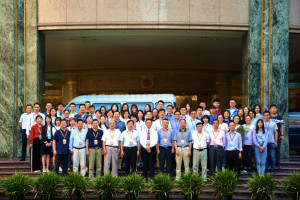The 2018 Symposium on Atmospheric Sciences in Colleges and Universities on Both Sides of the Taiwan Strait Was Held in Sichuan Hotel
On September 20-22, co-sponsored by Chengdu University of Information Technology, Chinese Culture University and Nanjing University of Information Science and Technology, the 2018 Symposium on Atmospheric Sciences in Colleges and Universities on both sides of the Taiwan Strait, co-organized by the Meteorological Committee of the Chinese Meteorological Society, was held in Sichuan Hotel. Nearly one hundred experts, scholars and young students from 17 schools and institutions attended the meeting, including Chinese Culture University; Taiwan University; Taiwan Normal University; National Central University; Zhejiang University; Nanjing University; Nanjing University of Information Science and Technology; Peking University; Beijing Normal University; Zhongshan University; Yunnan University; Lanzhou City University; Chengdu University of Information Technology; National University of Defense Technology; Northwest Institute of Ecology and Environment Resources, Chinese Academy of Sciences; Institute of Atmospheric Physics, Chinese Academy of Sciences; and the Gansu Meteorological Bureau. The opening ceremony of the conference was hosted by Zhang Yu, deputy director of the Science and Technology Department of Chengdu University of Information Technology.
At the opening ceremony, Professor Zeng Hongyang, the director of the Department of Atmospheric Sciences of the Chinese Culture University, delivered a speech and expressed sincere respect for the persistence and contribution of the older generation of meteorological researchers to the meteorological undertakings under difficult conditions, and greatly appreciated the new generation of colleagues who choose atmospheric science research under higher expectations, and hope that the symposium will be better and better.
Prof. Min Jinzhong, Vice President of Nanjing University of Information Science and Technology, delivered a speech. He briefly introduced the origin and history of the Symposium on Atmospheric Sciences in Colleges and Universities on both sides of the Taiwan Strait. He said that the conference aims to exchange and discuss frontier issues such as monitoring, mechanism, early warning and forecasting technologies for mesoscale weather, and to provide an opportunity for exchanges and interactions between relevant universities, research institutions and business departments on both sides of the Taiwan Strait, and to promote the level of scientific research in mesoscale weather and the friendship of atmospheric science workers on both sides of the strait.
Finally, Prof. Fan Guangzhou, Vice President of Chengdu University of Information Technology, delivered a speech on behalf of the organizer. He introduced the basic situation of our school and the customs of Chengdu to the participants, and extended a warm welcome to the experts and young scholars from the two sides of the strait. He said that the symposium is a high-standard and high-level exchange platform for cross-strait atmospheric sciences, providing an important platform for cross-strait scholars to explore academic frontier issues and exchange scientific research results, so that scholars on both sides can show their talents and scientific research results. Come out and interact closely with experts and scholars is of great significance to promoting the development of atmospheric science and cross-strait exchanges.
Subsequently, the meeting entered a one-and-a-half-day academic report exchange phase. Professor Zeng Hongyang from Chinese Culture University, Professor Min Jinzhong from Nanjing University of Information Science and Technology, Professor Liu Shuhua from Peking University, Researcher Zhang Qiang from Gansu Meteorological Bureau, Professor Fei Jianfang from National University of Defense Technology, Professor Wang Yuan from Nanjing University, and Professor Zhou Yunjun from our university were invited to report. The symposium exchanged 7 expert reports, 36 keynote reports and 12 wall posters. The communication report mainly focused on typhoon observation, typhoon development and evolution mechanism, mechanism affecting typhoon precipitation in Taiwan, parameterization scheme of plum rain and rainstorm forecast and effects of regional topographical features on heavy rain, vorticity and water vapor transport in mesoscale weather system, mesoscale weather triggering mechanism, mesoscale weather observation, cloud lightning, tornado disaster, convective-scale ensemble prediction and radar observation.
This symposium provides a good opportunity for exchanges and interactions between Taiwan and mainland universities, research institutions and business departments in the direction of mesoscale meteorological research, and enhances the scientific research level on mesoscale weather and the friendship between the scientific researchers on both sides of the strait.


